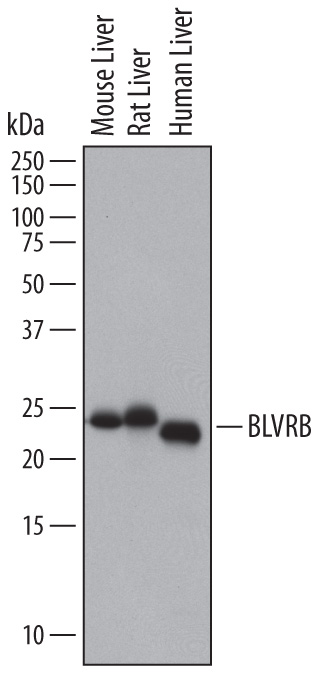Human/Mouse/Rat Biliverdin Reductase B/BLVRB Antibody
Human/Mouse/Rat Biliverdin Reductase B/BLVRB Antibody Summary
Ala2-Gln206, predicted
Accession # P30043
Applications
Please Note: Optimal dilutions should be determined by each laboratory for each application. General Protocols are available in the Technical Information section on our website.
Scientific Data
 View Larger
View Larger
Detection of Human, Mouse, and Rat Biliverdin Reductase B/BLVRB by Western Blot. Western blot shows lysates of human liver tissue, mouse liver tissue, and rat liver tissue. PVDF membrane was probed with 1 µg/mL of Sheep Anti-Human Biliverdin Reductase B/BLVRB Antigen Affinity-purified Polyclonal Antibody (Catalog # AF6568) followed by HRP-conjugated Anti-Sheep IgG Secondary Antibody (Catalog # HAF016). A specific band was detected for Biliverdin Reductase B/BLVRB at approximately 22 kDa (as indicated). This experiment was conducted under reducing conditions and using Immunoblot Buffer Group 1.
Reconstitution Calculator
Preparation and Storage
- 12 months from date of receipt, -20 to -70 °C as supplied.
- 1 month, 2 to 8 °C under sterile conditions after reconstitution.
- 6 months, -20 to -70 °C under sterile conditions after reconstitution.
Background: Biliverdin Reductase B/BLVRB
Clearance of heme in mammals is a two-step process starting with conversion of heme to biliverdin by heme oxygenase, followed by reduction of biliverdin to bilirubin by bilivredin reductase. Biliverdin IX b reductase (BLVRB) converts the beta isomer of biliverdin IX to bilirubin IX b, which constitutes 87% of total bilirubin in fetal bile. Therefore BLVRB is especially important for fetal heme metabolism and clearance (1). BLVRB is a cytoplasmic enzyme expressed at high levels in erythrocytes and liver, but is present in other tissues (2). The enzyme is identical to flavin reductase, which is an oxidoreductase that catalyses the NADPH-dependent reduction for a variety of flavins, such as riboflavin, FAD or FMN and met‑hemoglobin (3, 4). BLVRB is structurally distinct from BLVRA. In contrast to BLVRA, which prefers the biliverdin alpha isomer but could also use the beta isomer as substrate, BLVRB is specific for the beta isomer (5, 6).
- Pereira, P.J. et al. (2001) Nat. Struct. Biol. 8:215.
- Chikuba, K. et al. (1994) Biochem. Biophys. Res. Commun. 198:1170.
- Shalloe, F. et al. (1996) Biochem. J. 316:385.
- Cunningham, O. et al. (2000) Biochem. J. 345:393.
- Yamaguchi, T. et al. (1994) J. Biol. Chem. 269:24343.
- Cunningham, O. et al. (2000) J. Biol. Chem. 275:19009.
Product Datasheets
Citation for Human/Mouse/Rat Biliverdin Reductase B/BLVRB Antibody
R&D Systems personnel manually curate a database that contains references using R&D Systems products. The data collected includes not only links to publications in PubMed, but also provides information about sample types, species, and experimental conditions.
1 Citation: Showing 1 - 1
-
In silico and crystallographic studies identify key structural features of biliverdin IX? reductase inhibitors having nanomolar potency
Authors: NM Nesbitt, X Zheng, Z Li, JA Manso, WY Yen, LE Malone, J Ripoll-Roz, PJB Pereira, TJ Mantle, J Wang, WF Bahou
J. Biol. Chem., 2018-02-27;0(0):.
Species: Human
Sample Types: Cell Lysates
Applications: Western Blot
FAQs
No product specific FAQs exist for this product, however you may
View all Antibody FAQsReviews for Human/Mouse/Rat Biliverdin Reductase B/BLVRB Antibody
Average Rating: 5 (Based on 1 Review)
Have you used Human/Mouse/Rat Biliverdin Reductase B/BLVRB Antibody?
Submit a review and receive an Amazon gift card.
$25/€18/£15/$25CAN/¥75 Yuan/¥2500 Yen for a review with an image
$10/€7/£6/$10 CAD/¥70 Yuan/¥1110 Yen for a review without an image
Filter by:
BLVRB was over-expressed in human megakaryocyte progenitor cells and BLVRB expression was examined by western blot. Molecular weights (kD) are indicated on the left.


